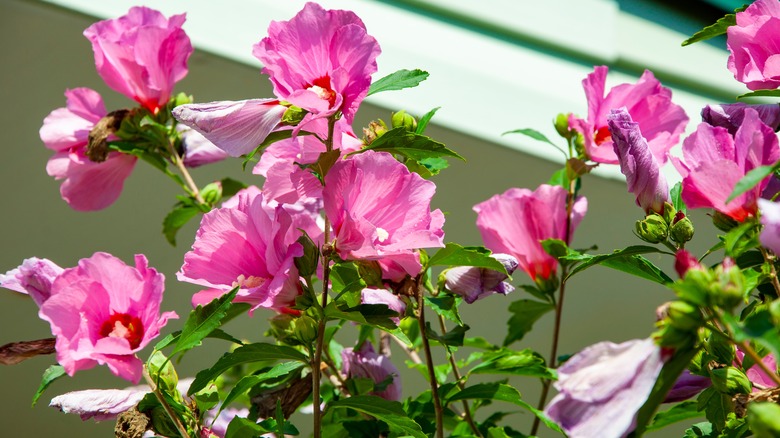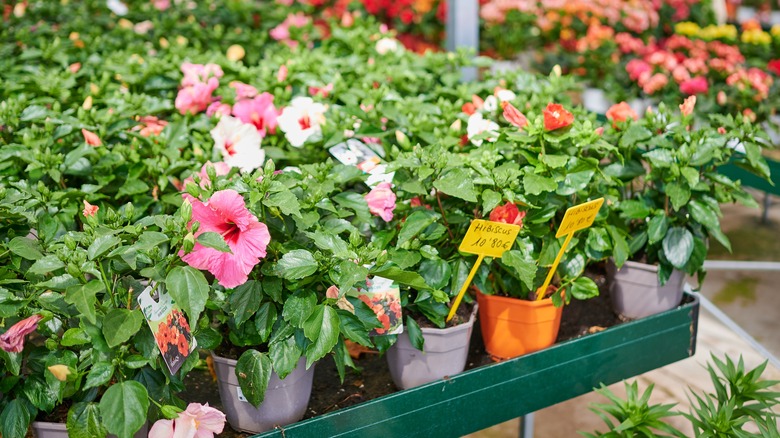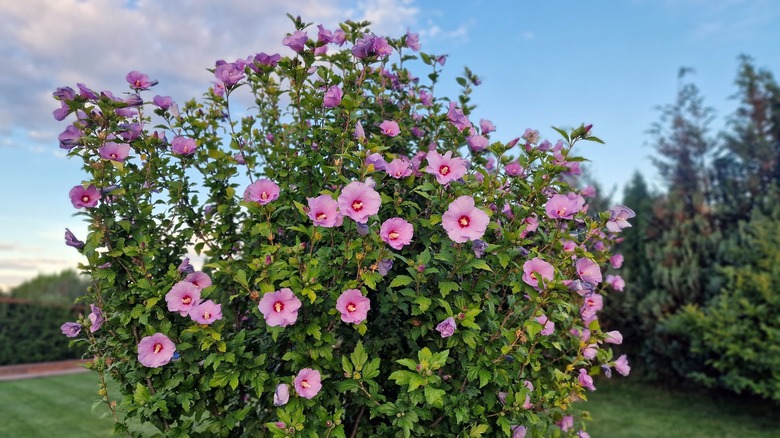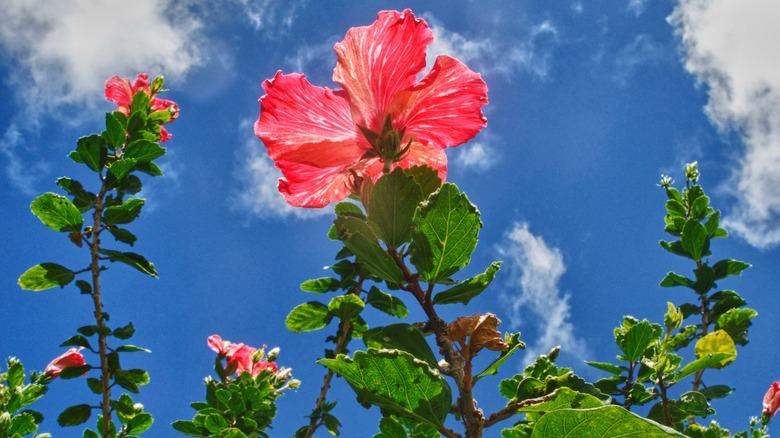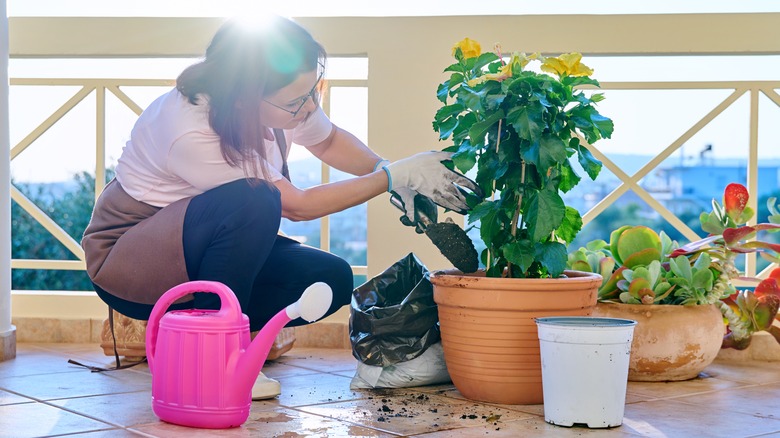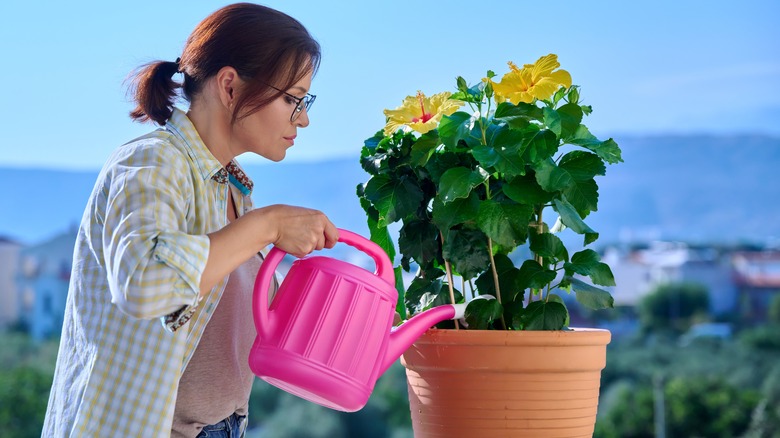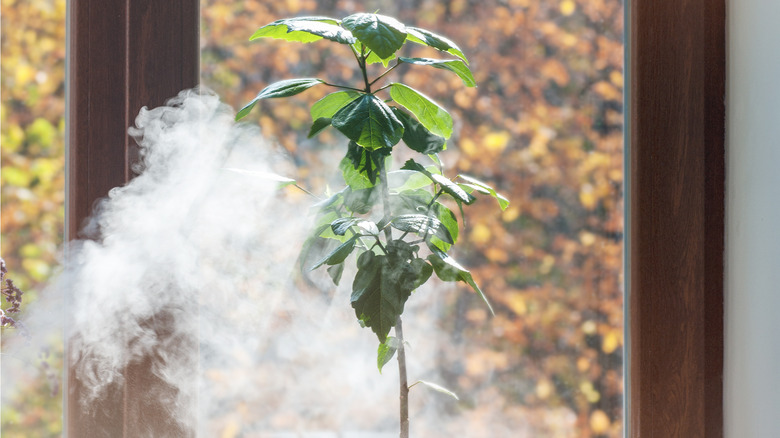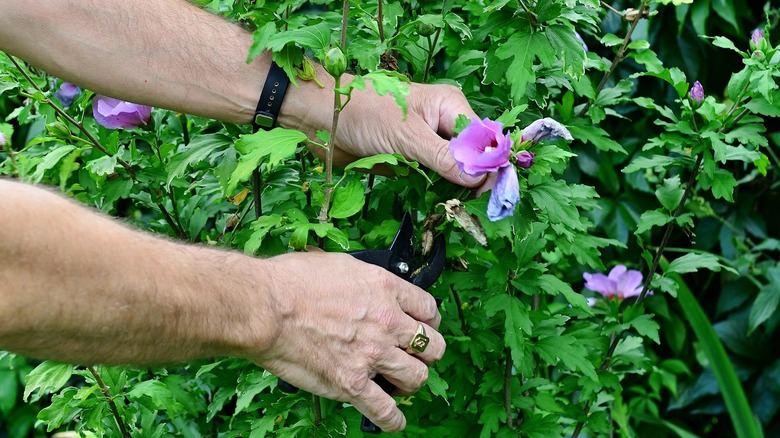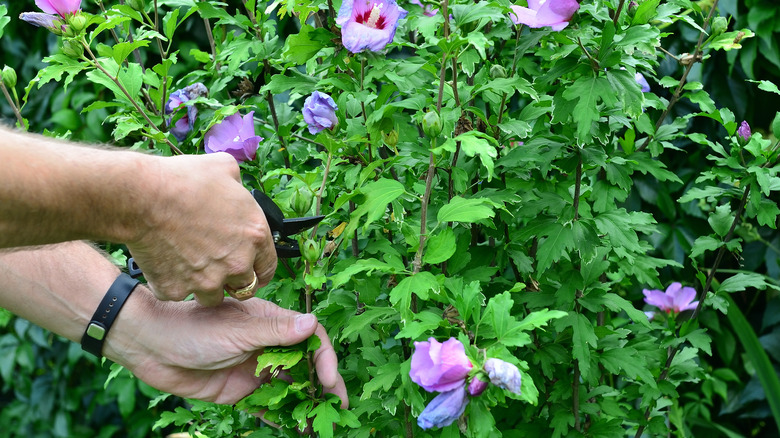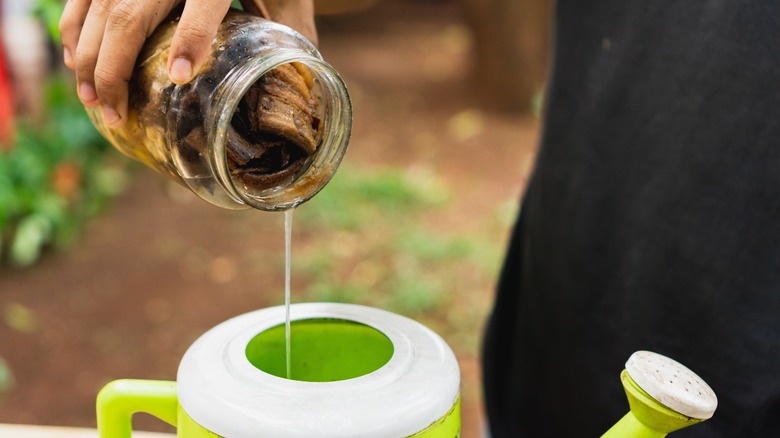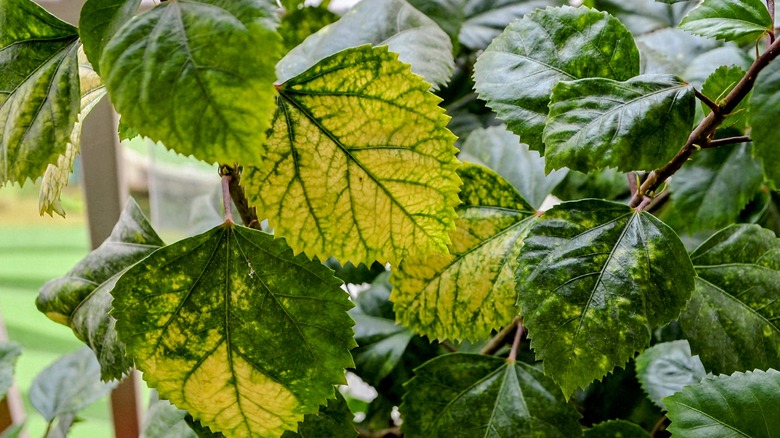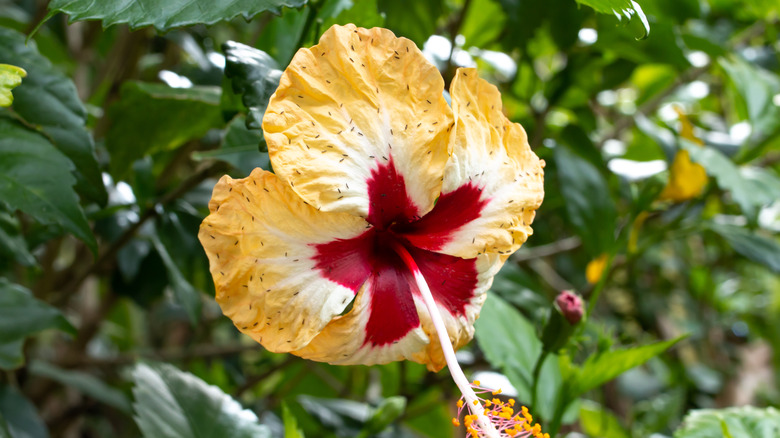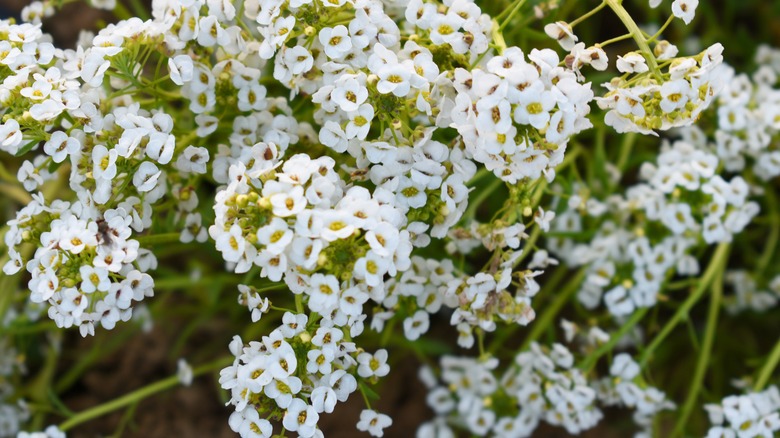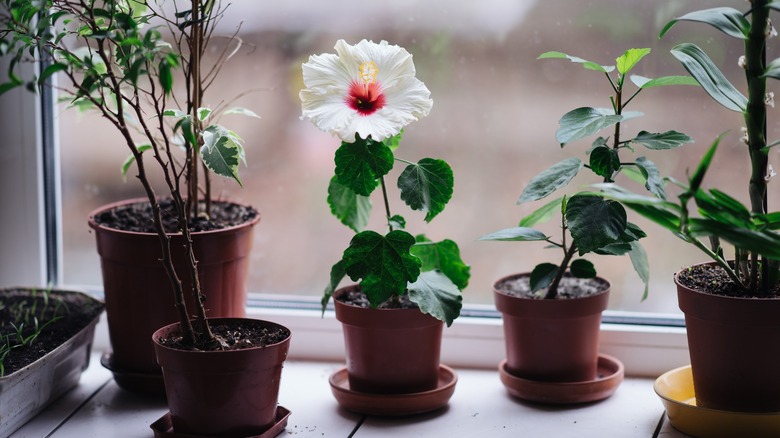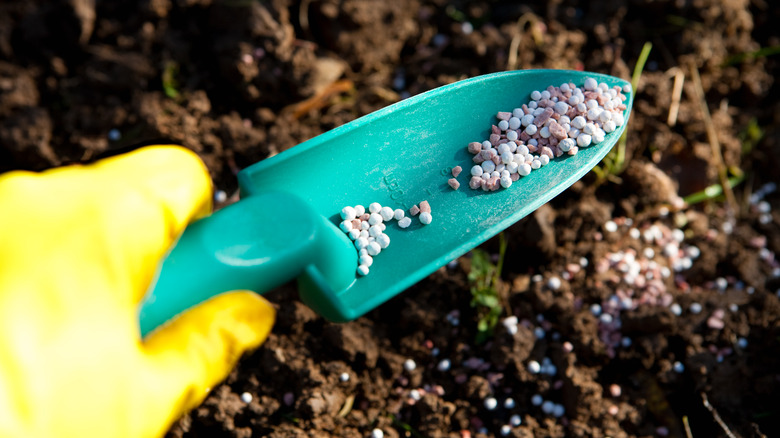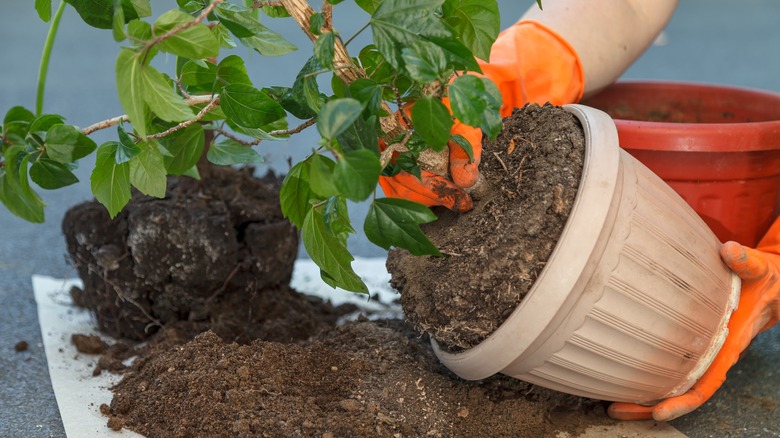Tips And Tricks To Keep Your Hibiscus Plant Growing And Thriving
Giving a tropical pop of color, hibiscus are flowering shrubs that pollinators love for their massive blooms. Although they may look exotic, there are hundreds of species within the genus, so gardeners in hardiness zones as low as 5 can enjoy their beauty. These showy flowers are typically low-maintenance, but they require a bit of care and attention to continue growing and thriving. As with other plants, you'll want to begin by making sure their basic needs are met, like choosing the right location and proper watering.
Even if you're tending to all their needs, simple mistakes or outside factors could lead to your hibiscus not living up to its potential. Unfortunately, it is no stranger to pests like slugs, mealybugs, aphids, and other invaders looking to feed. Diseases like hibiscus chlorotic ringspot, botrytis, and root rot can also wreak havoc on your flowers. Luckily, most of these issues are somewhat preventable, and simple tweaks will restore their vigor. With the proper knowledge and a bit of effort, you can enjoy having a flourishing hibiscus flooded with blooms each year.
Determine which hibiscus variety is best for your garden
Hibiscus flowers often evoke the image of sipping from a coconut on a sunny beach. However, there are several shrubs to choose from, with some being more cold-hardy than others. There are also several hybrid varieties of varying heights, some with even more cold-hardiness and longer blooming seasons. Before planting hibiscus flowers, read the care information to determine whether your garden suits your chosen variety's needs.
Although there are hundreds of hibiscus shrubs, there are two main types. As the name suggests, tropical hibiscus (Hibiscus rosa-sinensis) loves the sun and can't withstand temperatures below 50 degrees Fahrenheit. It comes in nearly every color of the rainbow and features glossy, dark green leaves. If you live in an area that has cold winters, they'll need to be brought inside until there's no more chance of frost. Alternatively, hardy hibiscus (Hibiscus moscheutos), also known as perennial hibiscus, can withstand the cold seasons in zones 4 to 9. This species dies back in the winter and returns in late spring. You'll have fewer color options, but they offer very large blooms, some being nearly a foot across.
Plant hibiscus at the right time of year
Considering the best time to plant hibiscus in your garden depends on your chosen variety and where you live. Tropical hibiscus (Hibiscus rosa-sinensis) can only grow in hardiness zones 10-12, like the Southern United States and Hawaii. If you live in an area that has seasons, plant them in the spring once the danger of frost has passed and nighttime temperatures are consistently above 50 degrees Fahrenheit. Doing so gives your shrubs a warm environment that allows them to begin establishing their roots. If you live in a more tropical area, it may be okay to plant them in fall or winter.
Hardy hibiscus (Hibiscus moscheutos), on the other hand, can withstand colder environments and may be planted in spring or fall. If you plant them later in the year, aim to do so at least six weeks before the expected first frost. This gives them time to adjust to their new environment before going dormant in winter. If planting in spring, wait until the ground warms up before introducing them to your garden.
Grow hibiscus in an area with full sun
No matter which variety you go with, there's no doubt your hibiscus flowers will prefer lots of sunshine. Every hibiscus plant thrives when planted in an area with full sun, receiving six to eight hours of light each day. Some varieties will tolerate part shade, though it can diminish their ability to grow and bloom. Too much shade can result in limited or even no flower production, so choose a location that doesn't have sunlight obstructions, like tall trees or buildings.
The only caveat to the amount of sun your hibiscus should receive is the temperature. If you live in a climate that experiences extreme heat, shade during the hottest part of the day can be beneficial. Yellowing leaves are the first clue you'll receive if your hibiscus is in an area that doesn't receive enough sun. Without sunlight, your shrub will fail to produce the chlorophyll needed to produce its dark, green foliage. Alternatively, if your plant is getting hit with too harsh of direct rays, the leaves will get leaf burn, appearing as white spots.
Choose a rich, well-drained soil mix
Like any plant, the right soil will make all the difference in the health of your hibiscus. Whether you opt for a tropical, hardy, or hybrid species, all hibiscus plants thrive in rich, well-drained soil. Compact soils can retain too much moisture, which can lead to harmful diseases like root rot. If you're growing your plant in a container, make sure it has drainage holes to allow excess water to flow out. To make a soil blend for hibiscus, combine 2 parts potting soil, 2 parts peat moss, and 1 part perlite. Supplementing the soil with organic matter, like compost, can make it even more nutrient-rich.
Some hibiscus plants prefer more acidity than others. Hardy hibiscus isn't too picky and will thrive in slightly acidic to slightly alkaline soil. On the other hand, tropical hibiscus likes neutral to slightly acidic sandy loam soil. If the soil is too alkaline, you can add sulfur to lower the pH. Another type, Rose of Sharon (Hibiscus syriacus) prefers neutral to alkaline soil, so make sure to adjust the soil pH levels based on your chosen variety.
Water regularly but avoid overwatering
Hibiscus needs plenty of water to grow and thrive, so it can be easy for eager gardeners to overdo it. It's important never to let the soil completely dry out, but overwatering can cause complications of its own. Signs you've given your shrub too much hydration are yellowing leaves, mushy stems or roots, and mold on top of the soil. Alternatively, if your hibiscus is thirsty, it'll let you know by displaying droopy or dried-out leaves. To determine if your hibiscus is in need of a deep shower, stick a finger into the soil and do a feel test. If the soil is dry or slightly damp, it's time to give it a drink.
It's important to note that overwatering doesn't mean you shouldn't thoroughly saturate the soil. To properly water your shrub, make sure water is pouring out of the drainage holes in potted plants and soaking through the soil to the roots if planted. Avoid letting any water land on the foliage or flowers, as it can lead to fungal issues. Overwintered plants will go dormant and require significantly less water in cooler months than in spring and summer.
Increase humidity levels for optimal blooming
As tropical plants, hibiscus thrives when in humid environments. If your tropical hibiscus isn't flowering as abundantly as it should, it could be due to a lack of humidity. Generally, these shrubs flourish with 50-60% humidity and will bloom more readily. While hardy hibiscus is humidity tolerant, they still prefer higher humidity levels to perform their best. Without sufficient moisture, hardy hibiscus may dry out, and tropical varieties may experience bud drop.
Many gardening experts recommend misting plants to increase humidity, but unfortunately, this often isn't enough to keep the levels high enough. Rather than misting your hibiscus several times a day, consider using a humidifier if growing your plants indoors. Another option is to fill a tray with gravel and water and place it below the base of the plant's pot. When the water evaporates, it will increase the humidity surrounding your hibiscus.
Encourage new blooms by deadheading
Deadheading, or removing spent blooms, is one of the best and easiest ways to encourage your hibiscus to bloom more frequently. While this isn't a necessary practice, it not only allows you to enjoy more flowers but also keeps your plant looking tidy. Both tropical and hardy hibiscus blooms only last about a day, but thankfully, the plant is constantly producing new buds. However, as the flowers fade, the plant shifts its energy into producing seeds rather than budding. By deadheading, you help divert the energy toward developing new blooms, encouraging them to bloom more vigorously during the growing season.
To deadhead your hibiscus, remove any flowers you notice are beginning to wilt or droop. You can do this by using your fingers to pinch them off or using a sharp pair of scissors or gardening shears to snip them just below the bloom. Be mindful when doing so, as you want to avoid disturbing any emerging buds. If using tools to cut off spent flowers, make sure they are clean and sanitized to avoid spreading diseases between cuts.
Prune regularly to maintain shape and size
Like any shrub, hibiscus plants can become a little unshapely without regular maintenance. Pruning isn't just about aesthetic appeal, though; it's also a method to help encourage new growth. More importantly, removing dead, damaged, and overcrowded branches improves plant health by encouraging airflow, which helps reduce the risk of fungal infections and other diseases that thrive in stagnant, humid conditions. Better airflow also allows the foliage to dry out more quickly after rain or watering, further preventing disease.
Determining when to prune your hibiscus depends on the type you have and the climate you live in. Prune hardy hibiscus in late winter or early spring before the plant shows new growth. Give your tropical hibiscus a good trim in the fall if you're in a warm-weather climate or if you bring the shrub inside near a sunny window for winter. Alternatively, hibiscus kept in dark rooms during overwintering should be pruned in spring. You may have to remove some flower buds and foliage during your pruning sessions, but don't worry; even more branches with fresh buds will appear later.
Add a boost of nutrition with banana peels
Did you know you can use leftover kitchen ingredients to fertilize your hibiscus plant? More specifically, you can use banana peels, which are rich in minerals like calcium and magnesium and contain bioactive compounds that encourage growth. Although more research needs to be done, one study by members of the University of Maiduguri, Nigeria shows that banana and pineapple peels can enhance agricultural productivity. When monitoring the growth of Hibiscus sabdariffa plants, they found that the one given banana peel powder sprouted the fastest, had the largest leaves, and grew the tallest.
To make a slow-release fertilizer out of banana peels, cut them into pieces and set them in the sun to dry out. Once dried, use a grinder or blender to grind them into a powder and mix it into your potting soil. You can also bury the dried chips (preferably ones with no additives) into your garden beds at the base of your plants. Repeat this process every few months. Another option is to make a liquid fertilizer by placing freshly cut-up banana peels into a container filled with water. Let them sit for a few days, strain out the chunks, and use the mixture to water your hibiscus plants. There is no solid answer on the best method for this little-studied trick, so try different things to see what might work.
Inspect leaves regularly for signs of disease
If your hibiscus flower plant is turning yellow, or you've noticed other irregularities in the foliage or flowers, it could be a sign of disease. Some common issues these shrubs are susceptible to include armillaria root rot, botrytis blight, leaf spots, crown rot, and hibiscus chlorotic ringspot virus. Diseases can weaken plants, reduce blooming, and even lead to plant death if not addressed as soon as possible. Checking in on your beloved plants can enable you to spot the signs more quickly, allowing you to treat them before the disease spreads and cause more damage.
Some signs to look out for include wilting, stunted growth, moldy spots, leaf discoloration, and other unusual-looking blemishes on the foliage. If you suspect your hibiscus has leaf spot or botrytis blight, remove and dispose of the affected foliage to prevent future spread. Unfortunately, there is no cure for diseases like armillaria root rot and hibiscus chlorotic ringspot virus, so the best course of action is to remove the infected plant to protect nearby plants.
Use neem oil to eliminate mites or aphids
Every plant enthusiast knows the pain of dealing with pests wreaking havoc on their favorite plants. From slimy slugs and snails to nearly microscopic invaders like aphids and black scale, these pests can quickly cause damage if not dealt with quickly. Each of these garden enemies appears differently, but keep an eye out for signs like damaged leaves, webbing, small bumps on foliage, sticky residue, and moldy-looking areas.
To prevent pests from taking over your hibiscus plants, keep up with removing dead plant debris, watering properly, and enhancing airflow. Healthy and well-maintained plants are less likely to be targeted, but that doesn't mean it doesn't happen. Neem oil is a natural insecticide that can prevent and control the infestations of several pests, including mealybugs, caterpillars, whiteflies, aphids, scales, and mites. When using this spray, make sure to cover the leaves and stems of your plants and follow any instructions it comes with. Natural pest-control methods are preferred to protect beneficial insects, so only use chemicals if necessary to manage a large infestation.
Plant sweet alyssum nearby to attract natural predators of hibiscus pests
Companion planting isn't an agreed upon science. Some scientists think it's bunk, while others see the benefits firsthand in studies. However, positioning certain plants together can't hurt, so you might as well try it to see if it's beneficial in your specific garden. If you're looking for a companion for hibiscus, try adding plants like sweet alyssum (Lobularia maritima) to attract pest-eating insects, like parasitic wasps. The Clemson University Fruit and Vegetable Research Associate Extension emphasizes that these natural predators can effectively manage pest populations in our gardens, minimizing the need for harsh pesticides that can harm pollinators and other beneficial insects.
Sweet alyssum pairs nicely with hibiscus in the garden because they thrive in similar environments. Both alyssum and hardy hibiscus are sun-loving perennials that live in the same soil type and require moderate watering. This flowering native will help attract our garden favorites like butterflies and bees, along with several natural predators like minute pirate bugs, parasitic wasps, and hoverflies. These insects act as a natural pest control, targeting harmful invaders like aphids, thrips, mites, beetles, mealybugs, scale, and some larvae. However, although some studies show the effectiveness of using plants to attract natural enemies, it doesn't necessarily mean the predators will gravitate to the plants you want them to. So, it's still important to maintain your usual pest-control management strategies.
Protect from frost during winter months
As the growing season ends, your hibiscus plant will need protection from the cold winter months. Tropical hibiscus is especially vulnerable to cold climates and cannot withstand temperatures below 50 degrees. Leaving your beloved plant outside puts them at risk of frost damage, and if left out long enough, it will likely not survive. If you live outside their native range, you'll need to take your tropical hibiscus inside for the winter. Once inside, place it near a sunny window (but not too close, to limit cold exposure) and reduce watering until spring rolls around.
If you only expect a few frosty nights in your area, mulching the area and laying a protective cloth over your shrub is sufficient for your tropical hibiscus. Regardless of how many cold nights you expect, you can leave your hardy hibiscus outside to overwinter. Similarly, use mulch and a frost cloth to help protect your perennial shrub and water less frequently.
Use a balanced fertilizer every few weeks
No matter the variety, hibiscus plants are heavy feeders and require extra nutrition to grow properly and put out vibrant blooms. Tropical hibiscus requires food high in potassium, which is responsible for nearly every aspect of plant growth, including blooming. However, your shrub won't benefit from a lot of phosphorus. Too much of this mineral can instead damage your once-healthy plant. Lastly, a moderate amount of nitrogen is best. Too little will inhibit its growth, while too much can cause leaf burn.
For hardy hibiscus, apply a balanced, slow-release fertilizer once the growing season begins and again in mid-summer. Give your tropical hibiscus a water-soluble 17-5-24 fertilizer with copper, magnesium, and iron regularly from spring through fall for optimal growth. Don't get too heavy-handed, however, as too much fertilizer can kill your shrub. So, always follow the instructions for your chosen feed and hold off if you notice delayed growth, discoloration, or other signs of declining plant health.
Repot container plants every couple of years to refresh soil
Although hibiscus plants enjoy being a bit root-bound, they can grow quickly and will need a new pot every few years. Transplanting them into a larger container gives them more space to grow and expand along with nutrients from adding fresh soil. Remove your plant from its pot and check the root ball each spring to determine if it's time to size up. If roots come out of the drainage holes or look compacted overall, it's time to upgrade.
When it comes time to repot your hibiscus, choose a container that's an inch or two bigger than the root ball. Gently remove it from its current pot, being careful not to damage the roots. Shake off as much soil as you can and remove any dead roots. Add a couple of inches of soil to the bottom of the pot and place the plant inside. Then, add new soil to the sides, gently pushing it down to release excess air, and top it off when it reaches the stem. Give your hibiscus a good watering, making sure water is coming out of the drainage holes.
